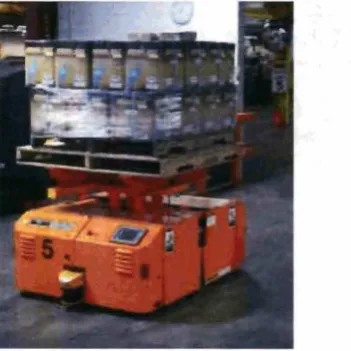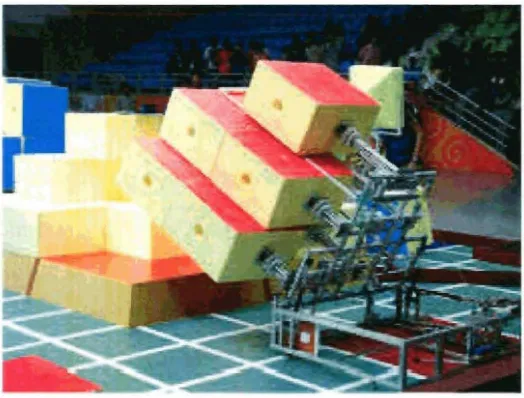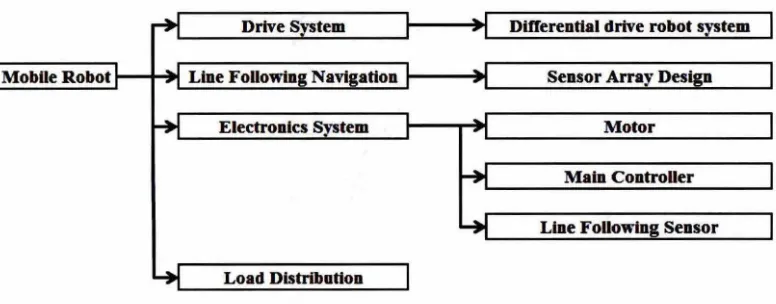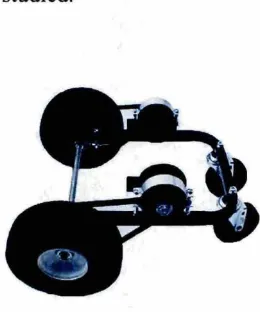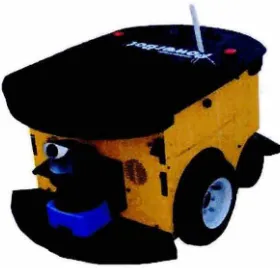UNIVERSITI TEKNIKAL MALAYSIA MELAKA
Faculty of Manufacturing Engineering
THE EFFECT OF LOAD DISTRIBUTION
TOW ARDS THE LINE FOLLOWING PERFORMANCE
OF TWO WHEEL DRIVEN MOBILE ROBOT
Muhammad Hafiz Bin Ahmad Sohan
Master of Manufacturing Engineering (Manufacturing System Engineering)
2014
THE EFFECT OF LOAD DISTRIBUTION TOWARDS THE LINE FOLLOWING PERFORMANCE OF TWO WHEEL DRIVEN MOBILE ROBOT
MUHAMMAD HAFIZ BIN AHMAD SOHAN
A thesis submitted
in fulfillment of the requirements for the degree of Master of Manufacturing Engineering (Manufacturing System Engineering)
Faculty of Manufacturing Engineering
UNIVERSITI TEKNIKAL MALAYSIA MELAKA
2014
DECLARATION
I declare that this thesis entitle "THE EFFECT OF LOAD DISTRIBUTION TOW ARDS THE LINE FOLLOWING PERFORMANCE OF TWO WHEEL DRNEN MOBILE ROBOT" is the result of my own research except as cited in the references. The thesis has
not been accepted for any degree and is not concurrently submitted in candidature of any other degree.
Signature ...
-tffe-Name Muhammad Hafiz Bin Ahmad Sohan
Date
J
NセN@ セ@ セNョ@.+.9.
l.4. ... ... .. ... .
APPROVAL
This report is submitted to the Faculty of Manufacturing Engineering of UTeM as a partial fulfillment of the requirements for the degree of Master of Manufacturing (Manufacturing System Engineering). The member of supervisory committee is as follow :
.
セセ@
Dr. FAIR UL A.ZNI BIN JAF AR
DR. FAIRUL AZNI BIN JAFAR
Head of Department {Robotic & Automation) Faculty of Manufacturin1 Engineering
Universiti Teknikal Malaysia Melaka Hang Tuah Jaya
76100 Durian Tunggal, Melaka
DEDICATION
To my beloved mother (Maznah Abu Bakar), wife (Nurul Zalikha Sha'ari), son (Muhammad Hariz Ziqri) and daughter (Zara Hasya Marissa). Thanks for all your prayers, outstanding support, patience and understanding.
ABSTRACT
In a mobile robot competition, it is often that the challenge includes carrying a load in the form of an object or sometime carrying another robot. The line following performance of the mobile robot might be affected by the way the load is distributed on top of them. To ensure the performance of line following, the mobile robot must be designed with these varying load distributions under consideration. Therefore, this thesis is designed to take the first step which is identifying the effect of load distribution towards the performance of line following. A two wheel driven mobile robot with a differential drive steering is developed with a platform to compensate different types of load distribution. A series of experiments is carried out to observe the effect of each type of load distribution towards the line following performance of the robot while completing the line following tasks. The performance of line following task is measured based on the time taken to complete a task and the frequency of line following sensors straying off the line. Data analysis is performed on results of the experiments to conclude the effect of each type of load distribution towards the line following performance. From the obtained result it can be concluded that the load distribution undoubtedly has effects towards the line following performance. The best position for load placement is at the centre of the robot polygon support which is represented by position 5 in the experiments. The outcome of this thesis research should benefits the development of load carrying mobile robot for competition and industrial automated guided vehicle which are navigated using the line following method.
ABSTRAK
Dalam sesebuah pertandingan robot bergerak, cabarannya kerap melibatkan muatan dalam bentuk objek yang perlu dibawa ataupun membawa sebuah robot yang lain. Prestasi robot bergerak mengikut garisan mungkin dipengaruhi oleh bagaimana muatan tersebut disusun atas robot. Bagi memastikan prestasi mengikut garisan, robot bergerak tersebut perlu direka dengan mengambil kira susunan muatan yang berbeza. Oleh sebab itu, tesis ini direka untuk mengambil langkah pertama iaitu mengenalpasti kesan susunan muatan terhadap prestasi mengikut garisan. Sebuah robot bergerak terpandu dua roda dengan stereng perbezaan pandu dibangunkan bersama platform yang boleh menampung susunan muatan yang berbeza jenis. Satu siri eksperimen dijalankan untuk memerhati kesan bagi setiap susunan muatan terhadap prestasi mengikut garisan oleh robot semasa melengkapkan tugasan-tugasan mengikut garisan. Prestasi tugasan mengikut garisan adalah diukur berdasarkan masa yang diambil untuk menyiapkan sebuah tugasan dan kekerapan penderia mengikut garisan tersasar keluar dari garisan. Analisis data dibuat terhadap keputusan eksperimen-eksperimen bagi menyimpulkan kesan bagi setiap jenis susunan muatan terhadap prestasi mengikut garisan. Daripada keputusan yang diperolehi, boleh disimpulkan tanpa keraguan bahawa susunan muatan mempunyai kesan terhadap prestasi mengikut garisan. Posisi yang terbaik untuk meletakkan muatan adalah di tengah-tengah poligon sokongan robot yang diwakili oleh posisi 5 di dalam eksperimen-eksperimen. Hasil tesis ini seharusnya membantu pembangunan robot bergerak yang membawa muatan dan kenderaan terpandu automatik yang dipanduarah menggunakan kaedah mengikut garisan.
ACKNOWLEDGEMENT
This dissertation would not have been possible without the guidance and the help of several individuals who in one way or another contributed and extended their valuable assistance in the preparation and completion of this study.
First and foremost, my utmost gratitude goes to Dr. Fairul Azni Bin Jafar whose sincerity and encouragement I will never forget. His guidance from the beginning of this thesis work has been my lifelines as I hurdle all the obstacles in the completion of this dissertation.
Last but not the least, my family and the one above all of us, the omnipresent Allah, for answering my prayers and for giving me the strength to plod on despite my constitution wanting to give up and throw in the towel, thank you so much Allah.
TABLE 3.1 3.2 3.3 3.4 3.5 3.6 3.7 3.8 3.9 4.1 4.2 4.3 4.4 4.5 4.6 4.7 4.8
LIST OF TABLES
TITLE
Factors, levels and responses of the experiment Design selection guidelines
General full factorial design of the experiment Line following task
Function of each IFC card
Conditions of line following sensors input
Responses to line following sensors input conditions Positions relation to robot physical structure
Assumption on effects of load positions Run sequence and parameters for experiments
Result and data analysis of time response for Experiment 1 Result and data analysis of sensors response for Experiment 1 Extensive analysis of time response for Experiment 1
Result and data analysis of time response for Experiment 2 Extensive analysis of time response for Experiment 2 Result and data analysis of time response for Experiment 3 Extensive analysis of time response for Experiment 3
©
Universiti Teknikal Malaysia MelakaLIST OF FIGURES
FIGURE TITLE PAGE
1.1 Unit load carrier carrying loads on-board 2
1.2 An automatic robot carrying building blocks to build th_e Pyramids
of Giza during Robocon Egypt 2010 3
2.1 Framework of literature review 6
2.2 A simple drive system for robot 7
2.3 An experimental differential drive automated guided vehicle 8
2.4 Powerbot - a high payload differential drive for research 8
2.5 Interface Free Controller by Cytron Technologies 10
2.6 LED-LDR combination for line following 11
2.7 Digital fiber-optic photoelectric sensor 11
2.8 IFC Digital Input Card 12
2.9 Line following navigation using 2 sensors,
(a) both sensors outside line 13
(b) both sensors inside the line 13
2.10 Line following navigation using the third sensor for junction detection 14
2.11 Placement of third Uunction) sensor,
(a) aligned with line following sensor 14
(b) aligned with driving wheels 14
2.12 Support polygon - tricycle vs. square base 16
3.1
Project flowchart18
3.2
Setup of drive system23
3.3
Main controller made of IFC cards24
3.4
Brushless motor driver25
3.5
Line following and junction detection sensors26
3.6
Lithium polymer batteries as the power source26
3.7
Position of line following sensors27
3.8
Position of junction sensors28
3.9
Flowchart of main program31
3.10
Displays of main program selection31
3.11
Flowchart of junction counting algorithm32
3.12
Flowchart of line following sensors algorithm33
3.13
Dumbbell plate35
3.14
Load positions on top of robot35
3.15
Positions relation to robot physical structure36
3.16
Two levels of load weight39
3.17
Load platform40
3.18
Load holding mechanism40
3.19
Line following course41
3.20
Conditions of starting point41
3.21
Straight line path42
3.22
Turning left/right path43
3.23
Result of power source test44
4.1
Time response on straight line course49
4.2
Frequency of Out_ Right condition51
4.3
Frequency of Out_ Left condition51
4.4
Frequency of Both_ outRight condition52
4.5
Frequency of Both_ outLeft condition52
4.6
Time response on left turning course56
4.7
Time response on right turning course59
5.1
Rank of position for all experiment62
LIST OF ABBREVIATIONS
ABU Asia-Pacific Broadcasting Union AGV Automated Guided Vehicle IFC Interface Free Controller
KG Kilogram
LDR Light Dependent Resistors LED Light Emitting Diodes
PIC Peripheral Interface Controller
v
VoltLIST OF APPENDICES
APPENDIX TITLE PAGE
A Line following mobile robot algorithm 72
B Data collection sheet of Experiment I
79
c
Data collection sheet of Experiment 2 80D Data collection sheet of Experiment 3 81
TABLE OF CONTENT
ABSTRACT ABSTRAK
ACKNOWLEDGEMENT LIST OF TABLES
LIST OF FIGURES
LIST OF ABBREVIATIONS LIST OF APPENDICES
CHAPTER
1. INTRODUCTION
1.1 Background
1.2
Research motivationl.3
Problem statement1.4
Objectives1.5
Scopes1.6
Report structure2. LITERATURE REVIEW
2.1
Overview2.2
Drive system2.2.1
Differential drive mobile robot2.3
Electronics system2.3.1
Motors2.3.2
Main controller2.3.3
Line following sensor2.4
Line following navigation2.4.1
Sensor array design2.5
Load distribution2.6
Summary3. METHODOLOGY
3.1
Overview3.2
Design of experiment3.3
Experimental setup3.3.1
Setup of drive system3.3.2
Setup of electronics system3.3.3
Setup of line following navigation3.3.3.1
Sensor array design3.3.3.2
Line following algorithm3.3.4
Setup of load distribution3.3.5
Setup of line following courses3.3.6
Setup of power source test3.4
Summary©
Universiti Teknikal Malaysia Melaka4. RESULT AND DISCUSSION
4.1 Overview
4.2 Experiment I - straight line course 4.2.1 Result of Experiment 1 4.2.2 Discussion
4.3 Experiment 2 - left turning course 4.3.1 Result of Experiment 2 4.3.2 Discussion
4.4 Experiment 3 - right turning course 4.4.1 Result of Experiment 3 4.4.2 Discussion
5. CONCLUSION AND RECOMMENDATIONS FOR FUTURE
RESEARCH
5.1 Conclusion
5 .2 Recommendations for future research
REFERENCES APPENDICES
©
Universiti Teknikal Malaysia MelakaCHAPTER I
INTRODUCTION
1.1 Background
Mobile robot competition have been around and inspired generations of students and researchers for decades (Braunl, 1999). In a robotic competition, the mobile robot usually has to navigate its way within the competition game field while performing certain tasks. One of the tasks is carrying a load in the form of an object or sometimes carrying another robot. In the Asia-Pacific region, Robocon is a very popular robot competition organized by the Asia-Pacific Broadcasting Union (ABU) which is held annually since 2002, just for university, college and polytechnic students in the region. It is a great platform to instill creativity and innovative thinking as students will design and fabricate their robot according to the rules and regulation.
In an environment where the navigation path is visible like a white line on a black surface (or vice-versa), line following mobile robot is a suitable candidate to perform the task (Islam and Rahman, 2013). Similar application is adopted in the industry where the terms ' automated guided vehicle' is used for a mobile robot that is utilized as a material handler inside the manufacturing facility (Kumar et al. , 2012). The development of automated guided vehicle that is capable of performing material handling task is not always cost effective (Ali et al., 2010). Therefore, line following navigation is often preferred because of its low cost, simple design and easy construction or adjustment of the navigation path (Li et al. , 2012).
1.2 Research motivation
The actual motivation that drives this research is the personal experience of the author during the national (Malaysia) competition of Robocon (Hong Kong) 2012. The competition task for that particular year relies more on robot's capability to carry loads. The automatic robot has to carry a load in the form of basket before having to carry and deliver another automatic robot on-board to another place. Robot's inefficiency to perform line following navigation while carrying load is detrimental to the team's success. Therefore, the result of this thesis would be crucial in obtaining the optimum way of distributing the load being carried by a line follower mobile robot during a robotic competition. Competitions provide a great platform for students involved in the project to meet experienced people in robotics field and expose them to problems in real life (Canada et al. , 2011). Besides improving the performance of line follower mobile robot in the robotic competition, the findings from this research are also beneficial to other areas utilizing mobile robot capability such as the industrial Automated Guided Vehicle (AGV). Similar load distribution approach can be adopted in an AGV system specifically the AGV Unit Load Carrier type which carry load on top of the vehicle (JBT Corporation, 2014).
Figure 1.1 Unit load carrier vehicle carrying loads on-board (Dex ion, 2012).
2
[image:18.489.174.350.492.668.2]1.3 Problem statement
In ABU ' s Robocon, load carrying is a very common task. During Robocon Kuala Lumpur 2006, robots have to carry building block as they compete to build the Petronas Twin Tower. Recently in Robocon Hong Kong 2012, robots are required to perform various loads carrying task which are carrying a basket and carrying another robot onboard (aburobocon2012, 2012). This is quite a difficult task because the load being carried will
not only affecting the stability of the robot while moving but will also affecting the line following efficiency of the robot. Therefore, one of the challenges in developing the robot is to determine how the load being carried should be distributed in order for the line following efficiency and the robot's stability not to be affected. The effect of load
distribution towards the efficiency of the line following mobile robot must be analysed prior to the development process of the robot.
Figure 1.2 An automatic robot carrying building blocks to build the Pyramids of Giza during Robocon Egypt 20 I 0 (wikipedia, 20 I 0).
3
[image:19.489.136.398.386.585.2]1.4 Objectives
The objectives of this project are:
L To develop a two wheel driven line following mobile robot with a platform to
compensate different types of load distribution.
1i. To observe the effect of each type of load distribution towards the line
following performance of the robot.
11i. To perform data analysis on results of the experiments so that the effect of each
type of load distribution towards the line following performance can be concluded.
1.5 Scopes
The scopes of this thesis will include but also limited to:
l. Two rear wheels drive mobile robot with a differential drive configuration and
two castor wheels on the front will be developed to run the experiments.
ii. The line following algorithm developed for the robot will be tuned based on the condition of the robot carrying no load.
ni. The performance of line following task will be measured based on the time
taken to complete a task and the frequency of line following sensors straying off the line.
4
1.6 Report structure
This thesis consists of five chapters. Each chapter is written with specific focus on
the research objectives and arranged in sequence parallel with the stages of this thesis.
Chapter 1 briefly introduces the research work carried out in this thesis. The
introduction consists of background, research motivation, problem statement, objectives,
and scopes of project.
Chapter 2 review all the literature study that is crucial for this thesis. It highlights
previous works from other researchers that are related to components and systems used for
research in this thesis.
Chapter 3 will shed some light on the project methodology which is details on
methods being used to solve problems in this research. The methods include design of
experiment, configurations for the robot and the experiment configurations.
The results of this research are presented in Chapter 4 where findings and analysis
will be further discussed.
Last but not least, Chapter 5 will conclude the outcome of this research and share
suggestions for future works that can be explored by other researchers especially the
robotic enthusiasts.
5
CHAPTER2
LITERATURE REVIEW
2.1 Overview
The diagram in figure 2.1 below will further illustrate the scope or framework of literature study carried out for this research. The structure shows the derivation of the broader area in the field of study as it goes down to the specific area being focused in this thesis.
Drive S tem DUlerentlal drive robot s tem
Electronics S tem Motor
Main Controller
Line Followtn Sensor
[image:22.478.47.435.337.489.2]Load Distribution
Figure 2.1 Framework of literature review
Mobile robotics is one of unique branch of robot category. By linking together processing unit with moving drive, one can be called mobile robot. The evolution of mobile robot has been moving very fast. Starting as a computer on wheel and utilized mainly in the industry, mobile robot has evolved in term of size, capability, area of application and impact to society. Recently, Chen (2010) had implemented the intelligent
system of mobile robot into an unmanned autonomous car. This breakthrough is welcomed in an effort to reduce accident rate due to careless driver.
[image:23.478.170.300.293.449.2]The application of mobile robot does not only limited to manufacturing industry. It already has a widespread application because the automation of transportation and delivery of materials in the production, service and trade sector is the crucial element of logistics' s optimization (Schulze, Behling and Buhrs, 2008). A line following mobile robot designed for the purpose of carrying medicine has prove to be very helpful in health care management system (Punetha, Kumar and Mehta, 2013). In order for mobile robot to have an efficient function in human environment, the drive system is one of the critical elements of mobile robot that have to be studied.
Figure 2.2 A simple drive system for robot (kadtronix, 2014)
2.2 Drive system
A locomotion mechanism is very important for a mobile robot as it enables the robot to move around the human environment (Siegwart and Nourbakhsh, 2004). Locomotion is the process that enables the robot to move and there is a lot of locomotion method that can be used in a mobile robot drive system. The standard locomotion mechanism that is widely used for a small mobile robot is the differential drive and steering drive.
7
2.2.1 Differential drive mobile robot
[image:24.478.172.307.281.452.2]A commonly used design for a mobile robot comprises of two rear drive wheels and one or two castor wheels at the front (Dhaouadi and Hatab, 2013). Each rear drive wheel placed on either side of the robot body is driven independently by its own controlled motor (Maddahi et al., 2011 ). The differential drive configuration does not need an additional steering motion because the robot can move forward, backward or making a turn by changing the direction of rotation for each wheel (Ravikumar, Saravanan and Nirrnal, 2013).
Figure 2.3 An experimental differential drive automated guided vehicle (Soysal, 2013)
Figure 2.4 PowerBot - a high payload differential drive for research (Lab, 2010)
8
[image:24.478.170.310.512.646.2]